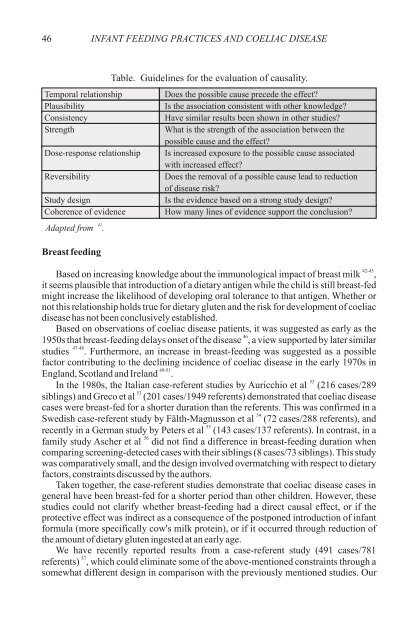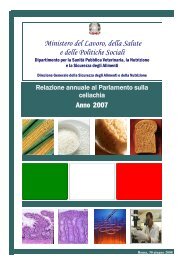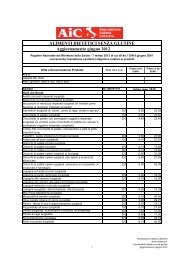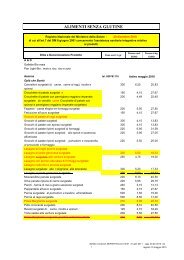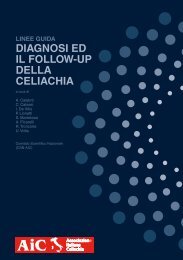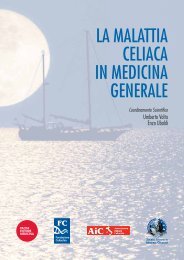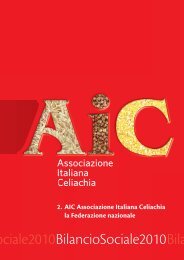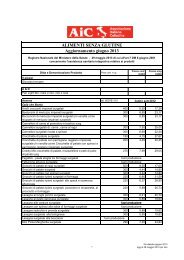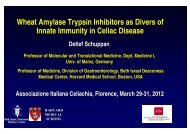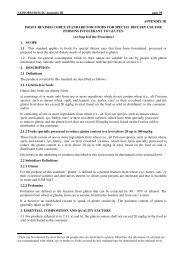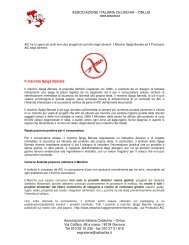primary prevention of coeliac disease - Associazione Italiana ...
primary prevention of coeliac disease - Associazione Italiana ...
primary prevention of coeliac disease - Associazione Italiana ...
You also want an ePaper? Increase the reach of your titles
YUMPU automatically turns print PDFs into web optimized ePapers that Google loves.
46 INFANT FEEDING PRACTICES AND COELIAC DISEASE<br />
Temporal relationship<br />
Plausibility<br />
Consistency<br />
Strength<br />
Dose-response relationship<br />
Reversibility<br />
Study design<br />
Coherence <strong>of</strong> evidence<br />
41<br />
Adapted from .<br />
Breast feeding<br />
Table. Guidelines for the evaluation <strong>of</strong> causality.<br />
Does the possible cause precede the effect?<br />
Is the association consistent with other knowledge?<br />
Have similar results been shown in other studies?<br />
What is the strength <strong>of</strong> the association between the<br />
possible cause and the effect?<br />
Is increased exposure to the possible cause associated<br />
with increased effect?<br />
Does the removal <strong>of</strong> a possible cause lead to reduction<br />
<strong>of</strong> <strong>disease</strong> risk?<br />
Is the evidence based on a strong study design?<br />
How many lines <strong>of</strong> evidence support the conclusion?<br />
42-45<br />
Based on increasing knowledge about the immunological impact <strong>of</strong> breast milk ,<br />
it seems plausible that introduction <strong>of</strong> a dietary antigen while the child is still breast-fed<br />
might increase the likelihood <strong>of</strong> developing oral tolerance to that antigen. Whether or<br />
not this relationship holds true for dietary gluten and the risk for development <strong>of</strong> <strong>coeliac</strong><br />
<strong>disease</strong> has not been conclusively established.<br />
Based on observations <strong>of</strong> <strong>coeliac</strong> <strong>disease</strong> patients, it was suggested as early as the<br />
46<br />
1950s that breast-feeding delays onset <strong>of</strong> the <strong>disease</strong> , a view supported by later similar<br />
47-48<br />
studies . Furthermore, an increase in breast-feeding was suggested as a possible<br />
factor contributing to the declining incidence <strong>of</strong> <strong>coeliac</strong> <strong>disease</strong> in the early 1970s in<br />
49-51<br />
England, Scotland and Ireland .<br />
52<br />
In the 1980s, the Italian case-referent studies by Auricchio et al (216 cases/289<br />
53<br />
siblings) and Greco et al (201 cases/1949 referents) demonstrated that <strong>coeliac</strong> <strong>disease</strong><br />
cases were breast-fed for a shorter duration than the referents. This was confirmed in a<br />
54<br />
Swedish case-referent study by Fälth-Magnusson et al (72 cases/288 referents), and<br />
55<br />
recently in a German study by Peters et al (143 cases/137 referents). In contrast, in a<br />
56<br />
family study Ascher et al did not find a difference in breast-feeding duration when<br />
comparing screening-detected cases with their siblings (8 cases/73 siblings). This study<br />
was comparatively small, and the design involved overmatching with respect to dietary<br />
factors, constraints discussed by the authors.<br />
Taken together, the case-referent studies demonstrate that <strong>coeliac</strong> <strong>disease</strong> cases in<br />
general have been breast-fed for a shorter period than other children. However, these<br />
studies could not clarify whether breast-feeding had a direct causal effect, or if the<br />
protective effect was indirect as a consequence <strong>of</strong> the postponed introduction <strong>of</strong> infant<br />
formula (more specifically cow's milk protein), or if it occurred through reduction <strong>of</strong><br />
the amount <strong>of</strong> dietary gluten ingested at an early age.<br />
We have recently reported results from a case-referent study (491 cases/781<br />
57<br />
referents) , which could eliminate some <strong>of</strong> the above-mentioned constraints through a<br />
somewhat different design in comparison with the previously mentioned studies. Our


